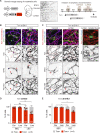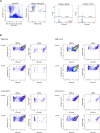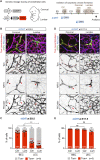Cdh5-lineage-independent origin of dermal lymphatics shown by temporally restricted lineage tracing
- PMID: 35961777
- PMCID: PMC9375154
- DOI: 10.26508/lsa.202201561
Cdh5-lineage-independent origin of dermal lymphatics shown by temporally restricted lineage tracing
Abstract
The developmental origins of lymphatic endothelial cells (LECs) have been under intense research after a century-long debate. Although previously thought to be of solely venous endothelial origin, additional sources of LECs were recently identified in multiple tissues in mice. Here, we investigated the regional differences in the origin(s) of the dermal lymphatic vasculature by lineage tracing using the pan-endothelial Cdh5-CreER T2 line. Tamoxifen-induced labeling of blood ECs at E9.5, before initiation of lymphatic development, traced most of the dermal LECs but with lower efficiency in the lumbar compared with the cervical skin. By contrast, when used at E9.5 but not at E11.5, 4-hydroxytamoxifen, the active metabolite of tamoxifen that provides a tighter window of Cre activity, revealed low labeling frequency of LECs, and lymphvasculogenic clusters in the lumbar skin in particular. Temporally restricted lineage tracing thus reveals contribution of LECs of Cdh5-lineage-independent origin to dermal lymphatic vasculature. Our results further highlight Cre induction strategy as a critical parameter in defining the temporal window for stage-specific lineage tracing during early developmental stages of rapid tissue differentiation.
© 2022 Zhang et al.
Conflict of interest statement
The authors declare that they have no conflict of interest.
Figures




Similar articles
-
Genetic Lineage Tracing of Lymphatic Endothelial Cells in Mice.Methods Mol Biol. 2018;1846:37-53. doi: 10.1007/978-1-4939-8712-2_3. Methods Mol Biol. 2018. PMID: 30242751
-
Pdgfrb-Cre targets lymphatic endothelial cells of both venous and non-venous origins.Genesis. 2016 Jun;54(6):350-8. doi: 10.1002/dvg.22939. Epub 2016 Apr 21. Genesis. 2016. PMID: 27060598 Free PMC article.
-
A blood capillary plexus-derived population of progenitor cells contributes to genesis of the dermal lymphatic vasculature during embryonic development.Development. 2018 May 17;145(10):dev160184. doi: 10.1242/dev.160184. Development. 2018. PMID: 29773646 Free PMC article.
-
A closer look at adipose tissue lymphatics and their markers.Curr Opin Hematol. 2022 May 1;29(3):144-150. doi: 10.1097/MOH.0000000000000712. Epub 2022 Feb 25. Curr Opin Hematol. 2022. PMID: 35220323 Review.
-
Role of lymphatic vasculature in regional and distant metastases.Microvasc Res. 2014 Sep;95:46-52. doi: 10.1016/j.mvr.2014.07.004. Epub 2014 Jul 12. Microvasc Res. 2014. PMID: 25026412 Free PMC article. Review.
References
Publication types
MeSH terms
Substances
LinkOut - more resources
Full Text Sources
Molecular Biology Databases
Miscellaneous
